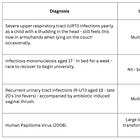Homeopathy & persistent pain
a true biopsychosocial model (and potential all-in-one treatment)
The Biopsychosocial model suggests that it is an individual’s own biological, psychological, and social experiences which contribute to and define their pain.
Persistent pain is now recognized as a primary health condition, with the totality of the sufferer emphasized in its management.
Dr. Jean-Lionel Bagot states that without doubt, in homeopathy, pain is the most studied symptom, with thousands of pain descriptors found within the repertory. Pain, as a subjective symptom, is analyzed via the sufferer who outlines their experiences, sensations and aetiology etc., which combine to form the totality which is matched to the homeopathic medicine that produced these specific peculiarities in its homeopathic pathogenetic trial data.12
For example, typically, the homeopath will record, as written clinical case notes, the totality during the consultation which becomes quantifiable via the standardized process of repertorization - usually in electronic format, used to quickly identify the homeopathic medicine which may be indicated, for differentiation (Fig.,1) and may, when contemporaneously conducted, mitigate self-reported memory bias and homeopathic medicine selection bias.3

Individualized homeopathy, always considering the totality of the sufferer, is in complete alignment with the biopsychosocial model of pain and, as a truly biopsychosocial treatment, has the potential to improve global well-being, energy levels, and multiple symptoms and dimensions of the sufferer concurrently.
When correctly used, homeopathy potentially has a lot to offer to persistent pain sufferers.
For example, During 2024 the European Journal of Rheumatology published Homeopathy for Rheumatological Diseases: A Systematic Review in six rheumatic disorders - fibromyalgia, ankylosing spondylitis, hyperuricemia, osteoarthritis, rheumatoid arthritis and tendinopathy stating ‘ homeopathy to be a promising and safe treatment option for rheumatological diseases, requiring further studies. ’4
REFERENCES
Bagot, JL. (2018). Pain in Oncology, Reality and Paradox of Homeopathic Care. OBM Integrative and Complementary Medicine. 3(3):019; doi:10.21926/obm.icm.1803019.
Frass, M., Lechleitner, P., Gründling, C, et al. (2020). Homeopathic Treatment as an Add-On Therapy May Improve Quality of Life and Prolong Survival in Patients with Non-Small Cell Lung Cancer: A Prospective, Randomized, Placebo-Controlled, Double-Blind, Three-Arm, Multicenter Study. Oncologist. Dec;25(12):e1930-e1955. Erratum: 2024 doi: 10.1093/oncolo/oyae253.
International Association for the Study of Pain [IASP], (2025) https://www.iasp-pain.org/resources/topics/pain-assessment-and-measurements/
Oberbaum, M., Singer, SR., Vithoulkas G. (2005). The colour of the homeopathic improvement: the multidimensional nature of the response to homeopathic therapy. Homeopathy. 94:196–199. doi: 10.1016/j.homp.2005.05.004
Schmidt, JM. (2012). The biopsychosocial model and its potential for a new theory of homeopathy. Homeopathy. Apr;101(2):121-8. doi: 10.1016/j.homp.2012.02.001
The Essential Synthesis. (2007). (F. Schroyens, Ed.) Homoeopathic Book Publishers.
Vithoulkas, G. (2014) The science of homeopathy. (7th ed.). International Academy of Classical Homeopathy.
Vithoulkas Compass. (2025). Homeopathy Software [computer program]. Greece.
Further reading (from this Substack)
‘In contrast to frequent claims, the available Meta Analyses of homoeopathy in placebo-controlled randomised trials for any indication show significant positive effects beyond placebo.
Compared to other medical interventions, the quality of evidence for efficacy of homoeopathy was similar or higher than for 90% of interventions across medicine.
Accordingly, the efficacy evidence from placebo-controlled randomised trials provides no justification for regulatory or political actions against homoeopathy in health-care systems.’5
Homeopathy & the homeopathic proving
Allen wrote it imperative that the real character of HPT symptoms are exposed and fully investigated to be incorporated, dropped, or stigmatized as dubious...
Homeopathy & Treasure
The Central Council for Research in Homeopathy (CCRH) has conducted over one hundred and ten Homoeopathic Pathogenetic Trials via the multi-centre double-blind placebo controlled method
Kaur, H., Jain, S., Katarmal, D. et al. (2024). The Patient Population at Homeopathic Outpatient Clinics across India: A Clinical Data Collection Study. Homeopathy. May 31. doi: 10.1055/s-0044-1782221
Freire de Carvalho, J., Lerner, A., Benzvi, C. (2024). Homeopathy for Rheumatological Diseases: A Systematic Review. Eur J Rheumatol. Oct 14;11(3):378-384. doi.org/10.5152/eurjrheum.2024.23123
Hamre HJ, Glockmann A, von Ammon K, Riley DS, Kiene H. (2023). Efficacy of homoeopathic treatment: Systematic review of meta-analyses of randomised placebo-controlled homoeopathy trials for any indication. Systematic Rev. 2023 Oct 7;12(1):191. https://systematicreviewsjournal.biomedcentral.com/articles/10.1186/s13643-023-02313-2#Abs1


















I became a homeopath because homeopathy cured my persistent pain. It sure wasn't because of placebo I can assure you!
Good information. Persistent pain is very troubling to manage.